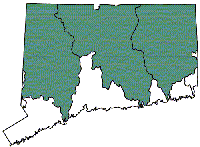Creeper
Strophitus undulatus
Key Features
Size: Up to three inches.
Shape: Subovate to subtrapezoidal. Valves usually laterally compressed, thin and fragile.
Periostracum: Color yellowish to greenish-brown (juveniles) to dark brown or black (adults). Shell rays usually only visible in juveniles or light-colored adults. Surface rough due to prominent growth lines.
Lateral Teeth: Absent.
Pseudocardinal Teeth: Present but extremely reduced—they are very simple swellings that are sometimes difficult to discern.
Nacre: Color usually white or bluish-white, and often yellowish-green toward the beak cavity.
Often Confused With ... The creeper can be confused with several other species, and it is important to examine the key features of all these species before making a positive identification. They include the eastern elliptio, brook floater, triangle floater, alewife floater, eastern floater, and dwarf wedgemussel.

External shell

Internal shell, right valve

Hinge teeth
 Habitat: The creeper only inhabits streams and rivers, and prefers sand and gravel.
Habitat: The creeper only inhabits streams and rivers, and prefers sand and gravel.
Range in Connecticut: The creeper is widespread but rarely abundant in Connecticut.
Conservation: Although the creeper appears to be doing well in Connecticut, it shares habitat with other listed species such as the brook floater and dwarf wedgemussel, and experiences many of the same environmental threats. Careful monitoring is needed to understand population trends in Connecticut. It is listed as special concern in Massachusetts and Maine.
Freshwater Mussel Fact Sheets
Eastern Pearlshell
Dwarf Wedgemussel
Triangle Floater
Brook Floater
Creeper
Eastern Elliptio
Eastern Floater
Alewife Floater
Eastern Pondmussel
Tidewater Mucket
Yellow Lampmussel
Eastern Lampmussel
The Freshwater Mussels of Connecticut
Content last updated on January 29, 2014.

